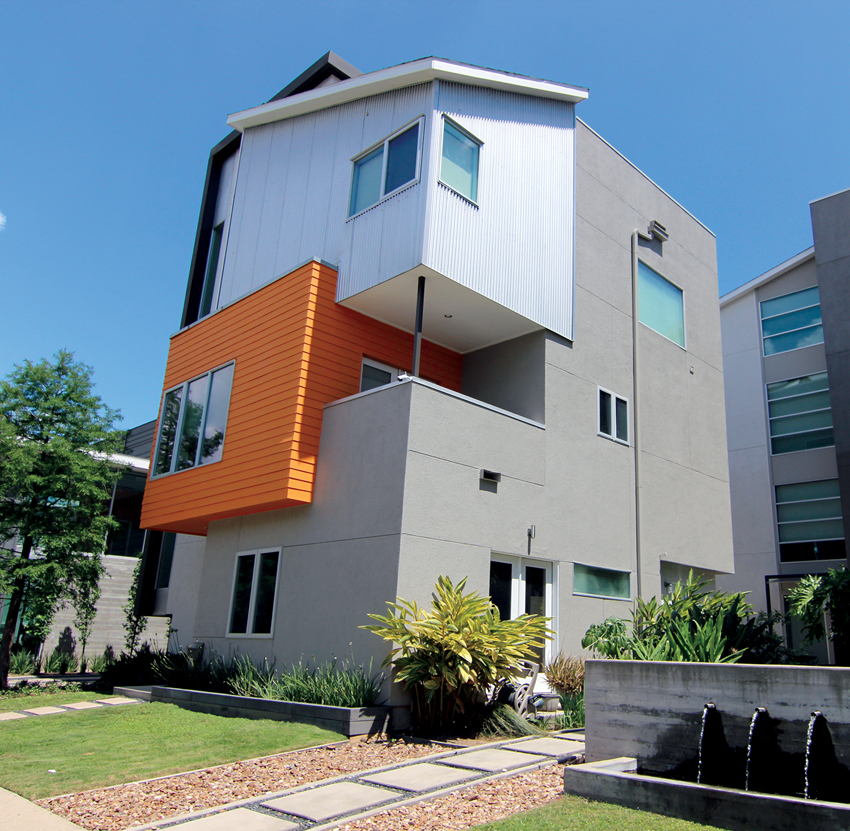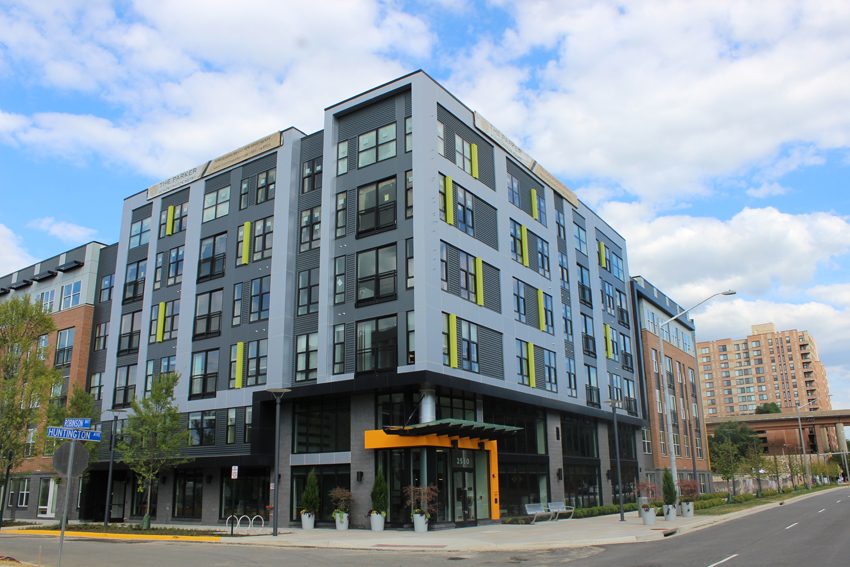This CE Center article is no longer eligible for receiving credits.
Extruded aluminum is unlike many other building materials because it does not need to fit standard profiles. It can be shaped to fit the design and structural needs of a given project, and this flexibility is beneficial for multifamily and commercial properties. The popular material provides high-quality practical shapes, forms, and profiles that have the appearance of fine metal craft and can be easily integrated into other surfaces for significantly less than custom metal work. Its clean appearance works well with modern designs.
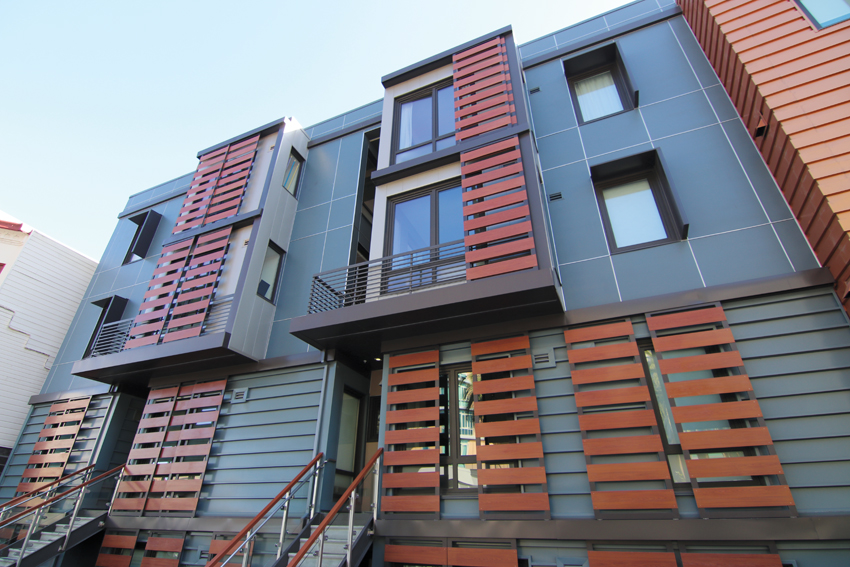
All photos courtesy of Tamlyn
Aluminum lasts a long time before it needs to be replaced, and its lightweight quality and ability to be recycled make it an ideal green building material.
This section of the course will focus on the flexible design elements of aluminum, and why it is a good material for multifamily and commercial properties. It will discuss the design preferences of groups such as Baby Boomers and Millennials who often occupy multifamily residences, as well as the material’s beneficial physical properties.
Modern Design Aesthetics in Multifamily Residential Properties
Before we go any deeper into the flexible characteristics of aluminum, it helps to get a better sense of how design trends have changed recently, with two key demographics moving into the multifamily residential market.
Baby Boomers and Millennials have had an impressive impact on multifamily residential properties, not only in terms of the features and amenities but also in the meaning of the space. Apartments and condominiums are no longer just places to live, but rather they reflect—and sometimes provide—aspects of the occupants’ lifestyles. For example, new building projects may incorporate ways to promote community through shared indoor or outdoor spaces. And building occupants value their individual residential units as a way to highlight their unique style. Many developers are taking on a “resident-first” tactic to project design, and this approach includes elements of new modern design aesthetics.
One trend that lends itself well to extruded aluminum is mixed-material design. Millennials in particular tend to be happy to mix older, more rustic materials with sleek, modern styles. Aluminum is versatile enough that it can accomplish either look: a clear anodized finish, for example, can keep the natural metal look, while a custom-color powder coating can add a splash of color into a space of plain drywall.
Also worth considering is dwelling size. Baby Boomers are in a downsizing stage of life while Millennials tend to be minimalists, so both demographics benefit from creative techniques that can fit added design features into the structure of a space. Walls that look like they are floating or with deliberate shadow lines built in, for example, can add a unique look to a small apartment or condominium unit. This attention to detail makes a multifamily project stand out from other buildings and may help draw tenants. As we will see, the variety of aluminum profiles and finishes can play an important role in a design, while also keeping projects within a fixed income or renter budget.

When used for interior architectural purposes, aluminum trim can withstand daily use and long-term wear and tear better than most other materials.
What Is Extruded Aluminum?
Aluminum is the most abundant metal in the earth’s crust. It is always found as a compound and often with bauxite ore, which contains around 30–60 percent aluminum oxide (known as alumina). Aluminum can be extracted from the bauxite and then smelted to form the aluminum metal that most people know. Because it is lightweight and durable, works in alloys, and is readily available through new extractions and recycled materials, aluminum is widely used in the transportation, packaging, and construction industries. It resists corrosion and is tolerant of high temperatures, making it ideal for commercial aircraft. It also is nontoxic and has low reactivity to light, water, and oxygen, which is ideal for food packaging as well as construction purposes—from windows and roofing to structural frames, gutters, and external and interior trim.
To get these versatile products, alumina first must undergo smelting and alloying. During this process, solid billets of cast metal are created, and these are later extruded through specialized forms to create the finished product. Following the extrusion process, the material is finished with anodizing or painting. The finishing process provides a range of colors, textures, and brightness to the aluminum.
Most extruded shapes used for architectural purposes are made from Type 6063-T5 aluminum. This aluminum alloy made with magnesium and silicon is commonly referred to as the “architectural alloy.” It has a very smooth surface that is well suited for anodizing applications. The T5 designation indicates that it has been artificially aged and moderately heat treated for strength.
Characteristics of Extruded Aluminum
Extruded aluminum is frequently referred to as the “miracle metal” because it has such an extensive list of favorable properties. These properties make it ideal not only for transportation uses such as commercial aircraft and trucking or food packaging but also for many different applications in the building industry.
Aluminum’s physical properties and characteristics are at the core of its versatility. As a material, it is strong, durable, and resilient—all while being lightweight. Where some materials are damaged on impact, aluminum can spring back (or be pushed back) to its original form. And unlike other metals, it does not rust, thanks to its own naturally occurring oxide film.
When used for interior architectural purposes, aluminum trim can withstand daily use and long-term wear and tear better than most other materials, which makes it a great option for multifamily residential projects. For example, it is tough enough to protect corners and bases, but unlike trim made from either PVC or wood, it will not deteriorate, warp, or be prone to insect damage. Extruded aluminum trim is also lightweight and very easy to install, and these features alone can be a great time and money saver during construction.
Aluminum ranks high in health and safety benefits, which we will cover in a later section. It also is strong in terms of sustainability (see Extruded Aluminum as a Green Solution sidebar). Given its physical characteristics, health and safety benefits, and overall sustainability, it is nice to know that aluminum is aesthetically versatile in terms of the forms and shapes that can be created, as well as the finishes and polishes. Extruded aluminum can be made into highly detailed designs and unique shapes that can be finished in a wide variety of textures, colors, and polishes. This versatility means that designers working on interiors easily can match the finishes of doors, windows, frames, and other interior features to create a unified interior design theme.
Extruded aluminum is unlike many other building materials because it does not need to fit standard profiles. It can be shaped to fit the design and structural needs of a given project, and this flexibility is beneficial for multifamily and commercial properties. The popular material provides high-quality practical shapes, forms, and profiles that have the appearance of fine metal craft and can be easily integrated into other surfaces for significantly less than custom metal work. Its clean appearance works well with modern designs.

All photos courtesy of Tamlyn
Aluminum lasts a long time before it needs to be replaced, and its lightweight quality and ability to be recycled make it an ideal green building material.
This section of the course will focus on the flexible design elements of aluminum, and why it is a good material for multifamily and commercial properties. It will discuss the design preferences of groups such as Baby Boomers and Millennials who often occupy multifamily residences, as well as the material’s beneficial physical properties.
Modern Design Aesthetics in Multifamily Residential Properties
Before we go any deeper into the flexible characteristics of aluminum, it helps to get a better sense of how design trends have changed recently, with two key demographics moving into the multifamily residential market.
Baby Boomers and Millennials have had an impressive impact on multifamily residential properties, not only in terms of the features and amenities but also in the meaning of the space. Apartments and condominiums are no longer just places to live, but rather they reflect—and sometimes provide—aspects of the occupants’ lifestyles. For example, new building projects may incorporate ways to promote community through shared indoor or outdoor spaces. And building occupants value their individual residential units as a way to highlight their unique style. Many developers are taking on a “resident-first” tactic to project design, and this approach includes elements of new modern design aesthetics.
One trend that lends itself well to extruded aluminum is mixed-material design. Millennials in particular tend to be happy to mix older, more rustic materials with sleek, modern styles. Aluminum is versatile enough that it can accomplish either look: a clear anodized finish, for example, can keep the natural metal look, while a custom-color powder coating can add a splash of color into a space of plain drywall.
Also worth considering is dwelling size. Baby Boomers are in a downsizing stage of life while Millennials tend to be minimalists, so both demographics benefit from creative techniques that can fit added design features into the structure of a space. Walls that look like they are floating or with deliberate shadow lines built in, for example, can add a unique look to a small apartment or condominium unit. This attention to detail makes a multifamily project stand out from other buildings and may help draw tenants. As we will see, the variety of aluminum profiles and finishes can play an important role in a design, while also keeping projects within a fixed income or renter budget.

When used for interior architectural purposes, aluminum trim can withstand daily use and long-term wear and tear better than most other materials.
What Is Extruded Aluminum?
Aluminum is the most abundant metal in the earth’s crust. It is always found as a compound and often with bauxite ore, which contains around 30–60 percent aluminum oxide (known as alumina). Aluminum can be extracted from the bauxite and then smelted to form the aluminum metal that most people know. Because it is lightweight and durable, works in alloys, and is readily available through new extractions and recycled materials, aluminum is widely used in the transportation, packaging, and construction industries. It resists corrosion and is tolerant of high temperatures, making it ideal for commercial aircraft. It also is nontoxic and has low reactivity to light, water, and oxygen, which is ideal for food packaging as well as construction purposes—from windows and roofing to structural frames, gutters, and external and interior trim.
To get these versatile products, alumina first must undergo smelting and alloying. During this process, solid billets of cast metal are created, and these are later extruded through specialized forms to create the finished product. Following the extrusion process, the material is finished with anodizing or painting. The finishing process provides a range of colors, textures, and brightness to the aluminum.
Most extruded shapes used for architectural purposes are made from Type 6063-T5 aluminum. This aluminum alloy made with magnesium and silicon is commonly referred to as the “architectural alloy.” It has a very smooth surface that is well suited for anodizing applications. The T5 designation indicates that it has been artificially aged and moderately heat treated for strength.
Characteristics of Extruded Aluminum
Extruded aluminum is frequently referred to as the “miracle metal” because it has such an extensive list of favorable properties. These properties make it ideal not only for transportation uses such as commercial aircraft and trucking or food packaging but also for many different applications in the building industry.
Aluminum’s physical properties and characteristics are at the core of its versatility. As a material, it is strong, durable, and resilient—all while being lightweight. Where some materials are damaged on impact, aluminum can spring back (or be pushed back) to its original form. And unlike other metals, it does not rust, thanks to its own naturally occurring oxide film.
When used for interior architectural purposes, aluminum trim can withstand daily use and long-term wear and tear better than most other materials, which makes it a great option for multifamily residential projects. For example, it is tough enough to protect corners and bases, but unlike trim made from either PVC or wood, it will not deteriorate, warp, or be prone to insect damage. Extruded aluminum trim is also lightweight and very easy to install, and these features alone can be a great time and money saver during construction.
Aluminum ranks high in health and safety benefits, which we will cover in a later section. It also is strong in terms of sustainability (see Extruded Aluminum as a Green Solution sidebar). Given its physical characteristics, health and safety benefits, and overall sustainability, it is nice to know that aluminum is aesthetically versatile in terms of the forms and shapes that can be created, as well as the finishes and polishes. Extruded aluminum can be made into highly detailed designs and unique shapes that can be finished in a wide variety of textures, colors, and polishes. This versatility means that designers working on interiors easily can match the finishes of doors, windows, frames, and other interior features to create a unified interior design theme.
Extruded Aluminum Can Lend Itself to Healthier Buildings
The recent pandemic has led to a wider discussion in the fields of architecture and construction about how pathogens and people intersect in the built environment. This conversation has led to exciting ideas about current research and development that focuses on the way that building materials and construction can produce healthier spaces, both now and into the future.
In this section, we will look at the ways in which aluminum is easier to sanitize compared to other materials, and how anodized and powder-coated finishes often show lower pathogen collection. We also will list a few studies and new technologies that show potential for furthering public health, which is important when it comes to spaces where multiple families live and commercial buildings where a variety of workers share space for long periods of time.
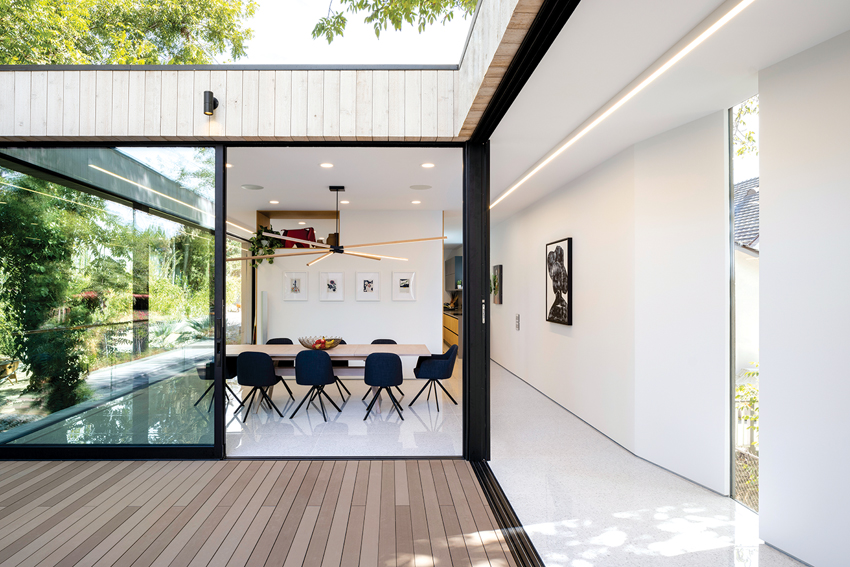
The recent pandemic has prompted more focused efforts to choose building materials such as extruded aluminum that can help mitigate the spread of viruses, bacteria, and infectious diseases in public and shared spaces.
Extruded Aluminum and Clean Surfaces
The recent pandemic has prompted more focused efforts to ensure clean surfaces. Even though COVID-19 now appears to spread through aerosol more so than on surfaces, considerations about how chosen building materials might impact the spread of viruses, bacteria, and infectious diseases in public and shared spaces has now become part of the larger conversation.
Regulated spaces such as hospitals and schools where viruses easily can pass from person to person likely will be looking for building solutions that provide an extra advantage in sanitation. Aluminum surfaces are easier to clean than many other surfaces because they are smooth, and their natural durability and corrosion-resistance allows them to endure long-term cleaning protocols. According to the Aluminum Association, soap and water, disinfectant wipes, and chemical solutions are all appropriate cleaning products to kill coronavirus on aluminum without damaging it or introducing other unhealthy culprits. The high thermal conductivity of aluminum makes it dry faster and therefore allows less time for bacteria to accumulate on the surface.
Low Pathogen Collection
In addition to its easy-to-clean surfaces, aluminum appears to inhibit the longevity of bacteria and viruses. This is because aluminum is inherently porous, creating microscopic pockets that can trap a virus and prevent it from transferring to other objects, including people’s skin. Research continues to shed light on the topic, but in multiple studies, the porous aspect of aluminum has shown an advantage.
A major study by researchers at the University of Greifswald’s Institute for Hygiene and Environmental Medicine in Greifswald, Germany, and the Ruhr University’s Department of Molecular and Medical Virology in Bochum, Germany, compared coronavirus’s ability to survive on various material surfaces. Two human strains of coronavirus were tested on several different types of surfaces. The results showed a virus survival time of only a few hours (2 to 8) on aluminum as opposed to multiple days (two to six) on other materials.
Anti-Pathogen Enhancement
New technologies in powder-coated and anodized finishes look promising for providing another layer of defense against pathogens. These finishing technologies can include additives that make the surface of aluminum even more inhospitable to bacteria and viruses. These antibacterial technologies still are being explored and require further scrutiny for how they impact humans and the environment, but the potential for pathogen-fighting finishes on surfaces such as aluminum that are already bacteria resistant seems to be on the horizon.
General Health
Beyond aluminum’s potential for safer surfaces, the material itself poses no health or physical hazards. It is fire resistant and noncombustible, and even at extremely high temperatures does not produce toxic fumes. According to the Occupational Safety and Health Administration (OSHA), aluminum products are safe enough to be classified as “articles,” which means they do not require published safety data sheets.
Expanded Finish Capabilities
When it comes to extruded aluminum, architects and designers have the luxury of an extensive array of choices for finishes and polishes. Extruded aluminum already has been fortified by the extrusion process itself in which an oxide film is formed that prevents corrosion. However, for aesthetic enhancement, extruded aluminum products can be finished with liquid paint or powder coating, anodization, or a mechanical finishing process, such as brushing or sand blasting.
As discussed earlier, the ability to find flexible and aesthetically rich designs for multifamily residences and commercial properties has become an important quality for builders. This section will outline the possibilities for extruded aluminum finishes, focusing on some of the more recently expanded capabilities of finish technology.
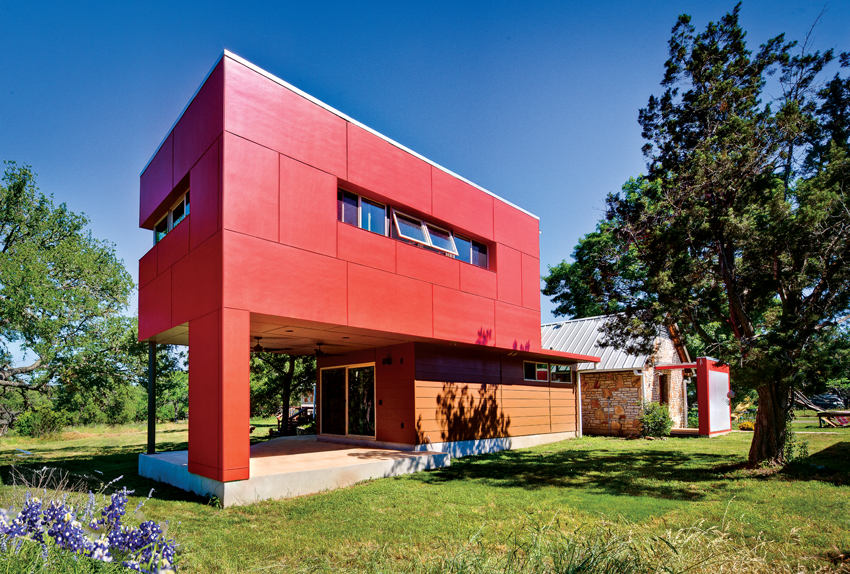
Powder-coated finish is popular not only because it is extremely high quality but also because it has a virtually limitless range of beautiful colors.
Color Design in Powder Coating
Aluminum products are available in a variety of finishes, including ready-to-paint finishes for custom color matching using liquid paints, such as acrylics, alkyds, polyester, and others, or powder coatings. They are also available in clear and colored-anodized finishes.
One of the more popular finishing options for extruded aluminum is a powder-coated finish. In fact, more than 15 percent of the total industrial finishing market uses powder-coated finishes. The finish is popular not only because it is extremely high quality but also because it has a virtually limitless range of beautiful colors.
Part of powder coating’s popularity stems from how it is produced and the resiliency of the final product. These coatings are based on polymer resin systems blended with curatives, pigments, leveling agents, flow modifiers, and other additives. The ingredients are melt mixed, cooled, and then ground into a powder. Once the powder is formed, it is applied to the aluminum substrate in a process known as electrostatic spray deposition (ESD). After the powder is applied, the substrate is heat cured; during this process, the coating chemically reacts to produce long molecular chains that are very strong and do not break down easily. This coating is much more durable than liquid paints. Where liquid paints are prone to eventual diminished quality from exposure to moisture, harsh weather, chemicals, and ultraviolet light, powder-coated aluminum is much stronger. As a more durable finish, powder coating resists scratches, chipping, corrosion, fading, and other wear issues that are known to negatively impact liquid-painted surfaces.
An advantage of powder coating is that its colors can be predictable and consistent. High-quality powder is a key factor in keeping batches consistent, and better ingredients result in closer color matches and generally better aesthetics.
AAMA 2604 powder coatings are formulated with super durable or modified polyester resins. This finish provides good color and gloss retention for approximately five years of exposure. AAMA 2605 is the high-performance exterior specification. These finishes are resistant to moisture, weathering, ozone, and ultraviolet radiation.
It is not just about the powder quality. Application processing and equipment also play a role in the consistency and vibrancy of powder-coated products. Processing a full job on the same coating line without much interruption is key to consistency, and this is an advantage of in-house powder-coating operations.
Recent advances in powder-coated finishes allow companies to provide a variety of looks beyond pure color. For instance, there are new powder coatings for matte and chrome finishes that provide exciting design elements to all major siding colors.
Liquid Paint
Liquid paint is one of the more popular finishes for extruded aluminum products because of the vast array of available colors. In fact, it tends to offer more colors than other finishing processes because the paint can be mixed as an artist mixes colors on a palette, making options nearly endless. Besides the variety of color, liquid paint finishes are available in a wide array of paint types, including acrylics, polyesters, silicone polyesters, and PVDF.
Liquid paint also does not require large-batch production. The ease in which you can find the color you need makes it easy to match whatever you are looking for.
There are a few drawbacks to liquid paint compared to powder coating. Liquid paint contains solvents with volatile organic compounds (VOCs) that are harmful to humans and not good for the environment. Because they are harmful in the application process, manufacturers must use abatement systems to use liquid paint, and this drives up the cost for the product. In comparison to powder coating, liquid paint is sometimes slightly more wasteful because any oversprayed paint cannot be reused. Finally, though they offer more color options than powder coating, liquid paint finishes can vary in appearance because of day-to-day variations in process, equipment, and general conditions.
Anodized Finishes
Anodizing is an electrochemical process that changes a metal’s surface into an anodic oxide finish that is decorative, durable, and corrosion resistant. The process is accomplished by dipping aluminum into an acid electrolyte bath and passing an electric current through the medium. The process allows aluminum oxide to fully integrate into the substrate of the product. Anodizing helps guard against corrosion but does not increase the strength of the aluminum itself.
The result of anodizing is a decorative, dynamic, and shiny surface. Especially if the goal is to sport a metallic look, anodizing is one approach that provides that style in an elegant manner.
The process creates a more porous surface, which is great for making dyes last longer if a color is applied afterward. The dye is locked in, integrated as part of the aluminum itself, and will not peel or fade with sunlight.
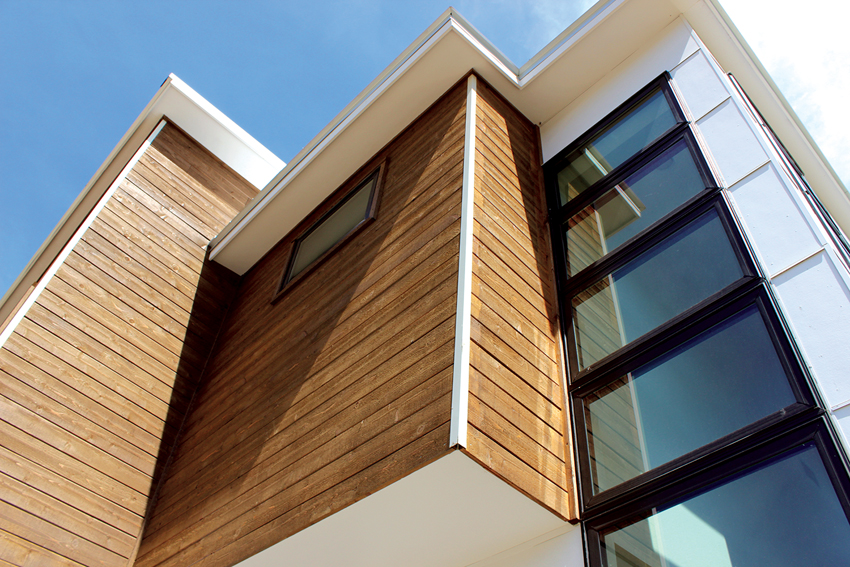
In recent years, some companies have started to skip the traditional anodizing process for powder-coat finishes with an anodized sheen in colors such as dark bronze or black.
Skipping the Dip
In recent years, some companies have started to skip the traditional anodizing process for finishing. Instead, they use a powder coating that has anodized sheen and is applied more quickly and easily than the process of anodizing requires. The coating is available in colors such as dark bronze, medium bronze, light bronze, gold, and black, which are within the industry range of color consistency but can vary from product to product depending on needs.
There are many advantages to skipping the dip, including the fact that the anodized coating allows for more consistency in color across product lines. It also has other cost and time advantages for both the manufacturer and the customer, which we will discuss in the next section.
Extruded Aluminum Cost and Lead-Time Advantages
Cost is a major factor for any project. In addition, lead time is an issue that plagues manufacturers, whether they are up against a pandemic or not. This section will talk about how new finishing technology for extruded aluminum can save money and time and also provide better quality control.
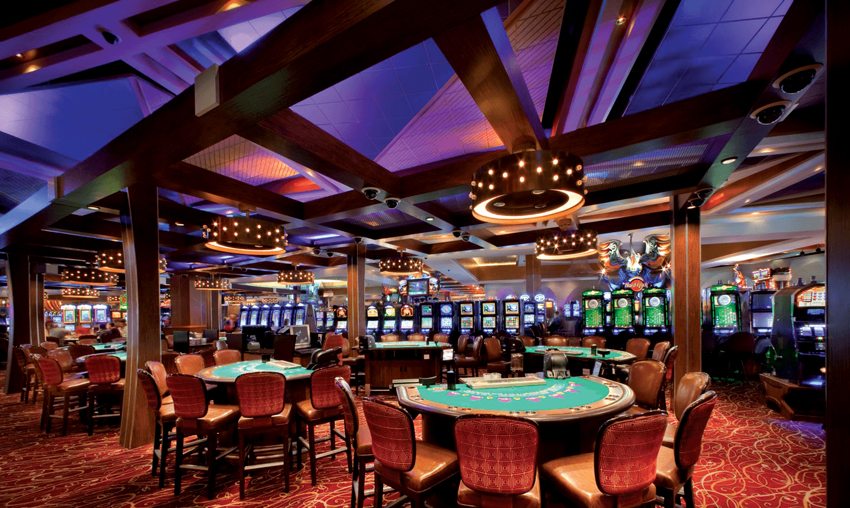
Aluminum offers many possibilities for light fixtures, such as these low-maintenance but aesthetically pleasing lights hanging in a Hard Rock Cafe.
Skipping the Dip
The lead time for anodizing extruded aluminum products can be up to four weeks depending on if you are using an outside or in-house anodizer. It takes about 720 amp minutes per square foot to produce 1 mil of oxide, so even in-house, the process can hold up a product line for a significant amount of time.
Those who are wanting small batches of finished extruded aluminum product are sometimes out of luck if a process requires large batches. Minimum order quantities (MOQs) often are an unexpected and significant expense to a buyer. And if the extra product is not used, it is also a waste of material with a negative impact on the environment.
Even if a buyer will eventually want a large batch, it is often the case that a buyer is looking to order a small batch first as a way to sample the product.
It might seem like manufacturers are just trying to keep orders big to make more money, but the truth is that small batches cost the manufacturer more due to economic and technical reasons. The preparation, manpower, and time required ends up outweighing the benefits when so much overhead is put toward small batches in a high-production setting or process.
Therefore, skipping the anodizing process and using anodized color powder coating can cut back on lead time. It also removes minimum order barriers since the coating process does not need to happen in large batches like it does with anodizing.
Other In-House Advantages
Extruded aluminum products that can be finished in-house allow manufacturers to cut down on expenses and pass those savings onto the buyer. Transportation and other middleman expenses can be cut out, and communication between manufacturer and buyer is not as apt to breakdown.
It also means that the soup-to-nuts process is overseen by one company, and this can lead to better quality control. The flow of quality-control checks can take place in one setting with a system in place that can ensure a product meets standards from the moment it is cast through the finishing process and into the hands of the buyer.
Extruded Aluminum and Its Real-World Applications
Extruded aluminum has many real-world applications, and these applications have expanded in recent years. The material is popular because its versatility in both shape and color can be integrated into a multitude of building products, including drywall, light fixtures, acoustic ceilings, and millwork.
In this final section, we will explore how extruded aluminum advances the quality of everyday products and describe the mechanical properties of these real-world products.
Drywall
Interior drywall surfaces in multifamily residential projects can easily and affordably be enhanced with extruded aluminum trim, which can turn the surface into a feature or focal point and drastically transform the space. Where custom metalwork is costly to design, detail, and fabricate, extruded aluminum trim can present a similar look at a fraction of the cost. As a design feature, aluminum trim can provide architects and designers with a means for creating clean, modern designs while incorporating the sustainable features and performance characteristics of aluminum.
Working with Drywall in Multifamily Projects
Multifamily residential projects have a unique set of challenges when it comes to drywall interiors. In particular, these buildings are subject to much more wear and tear than single-family homes because of frequent occupant turnover. When tenants move in and out of the units, there inevitably is drywall damage from oversized items that puncture walls, chip corners, damage overhead archways, and otherwise impact the wall surface. Repairing or replacing damaged surfaces can be costly, but leaving them untreated reflects poorly on the overall property. The trick is to design the space with materials that provide modern architectural design aesthetics while accounting for the bumps, bashes, and dents that come with tenants. One area where designers can keep drywall looking good is trim details.
Trim products generally are made of a wide variety of materials depending on the application. Some of the more commonly used materials include polyvinyl chloride (PVC), wood, rubber, and aluminum. Each material has its own advantages and disadvantages, and some trim materials are better for certain applications than others—some are also more costly than others, and so they may not be the best choice for multifamily residential projects. But when it comes to cost-effectiveness and durability, extruded aluminum trim offers a sleek, modern aesthetic that can help multifamily residential projects keep expenses down. We will discuss these qualities in the next section.
As an interior design material, extruded aluminum trim is considered a top performer for many reasons, but particularly because it is lightweight, inexpensive, and looks good. This material is versatile and can be used in place of more expensive metals to provide high-quality details on drywall surfaces that both meet a designer’s aesthetic eye and protect drywall with a strong, durable material. Extruded aluminum is also easy to install, which can drastically reduce project times and costs compared to more custom metalwork.
Light Fixtures
The use of light-emitting diodes (LEDs) has grown rapidly because of the energy use and maintenance costs. The U.S. Department of Energy (DOE) estimated that nearly 50 million LEDs have been installed in applications ranging from indoors to streetlights to parking garages. However, the rise in use of LEDs has created new challenges for lighting fixture manufacturers. LEDs require little maintenance and can be installed in all kinds of dynamic environments, which means that the fixtures must also be easy to maintain and durable.
Aluminum extrusion fixtures have become a solid solution to the challenge. LEDs are cool to the touch within the devices themselves, but they still emit unwanted heat due to inefficient semiconductors that generate the light. Aluminum extrusion fixtures serve as excellent heat sinks while also reflecting more light. In more chaotic environments, such as outdoor settings where they are not sheltered from weather, aluminum fixtures provide a corrosion-resistant alternative to other more costly fixtures.
Design-wise, the flexibility of aluminum fixtures brings more possibilities. The material can incorporate effects like lenses, circuit boards, and end-caps but also allow designers to create fixtures in any shape they desire with almost any artistic style they can imagine. The low-maintenance, high-style quality allows more flexibility both in function and aesthetics. Rather than just being a necessary response to the LED phenomenon, extruded aluminum can be seen as a desirable material for product designers.
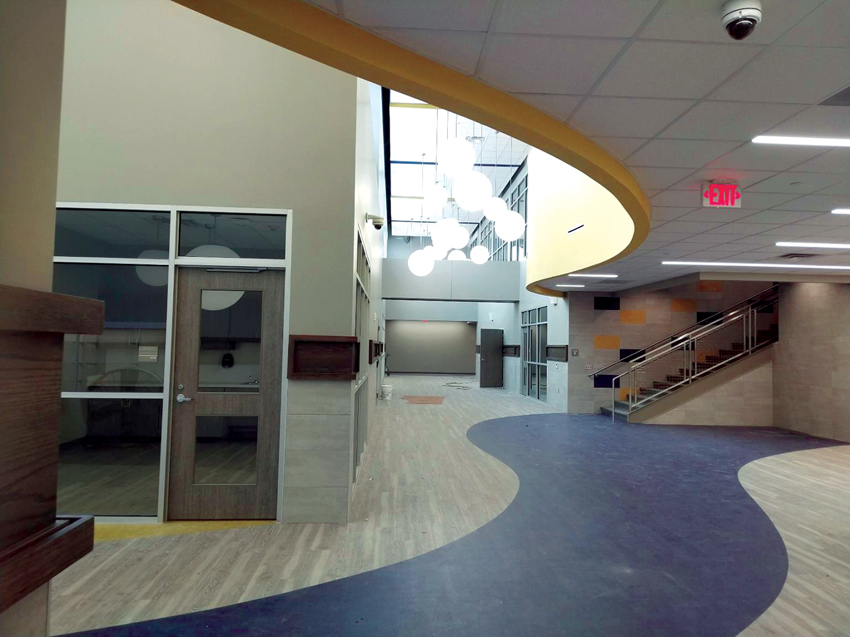
Acoustical ceilings created from extruded aluminum can transform a room from bland to modern, like this design in an elementary school.
Acoustical Ceilings
Acoustical ceilings have become popular in all kinds of spaces, including homes, businesses, and schools. On a functional level, they help lower the height of a room and provide better acoustics in spaces that otherwise fill with the din of ambient noise.
On an aesthetic level, they can hide unseemly objects, including pipes and cooling or heating ducts, and are especially good for remodeling basements or industrial settings without a total and costly makeover.
Even though they often are used as a way to fix a space that is unsatisfactory, the possibilities for acoustical ceilings can be transformative in a positive way. With a little innovation and creative design sense, acoustical ceilings can change an otherwise bland room into a modern, artistic sanctuary with an acoustic design that serves the purpose of the room to the highest degree.
The flexibility of extruded aluminum lends itself to a lot of these goals. Extruded aluminum panels, trim, tiles, and other profiles can be utilized in an acoustical ceiling system. As with light fixtures, the possibilities are extensive because the material can be shaped into curves that allow designers to play with the acoustics of a room and provide an aesthetic that interacts with the lighting.
The Allure of Extruded Aluminum Trim
According to Building and Developer magazine, Millennials have become the fastest-growing segment of the housing and rental market, with an estimated 2 million new households peaking at around 40 million dwellings in 2021. With these estimates, building professionals had better understand the wants and needs of this demographic.
So, what are these wants and needs, and how can architects, designers, and developers best accommodate them? And, in the context of this article, what role can extruded aluminum trim play in helping to meet these wants and needs?
While there are many different housing design trends associated with the Millennial demographic, the trends that stand out emphasize small, light spaces that are very flexible when it comes to moving and redecorating and can be used for at-home work. In addition, Millennials value designs that incorporate socially responsible materials and easily foster community gathering opportunities. Multifamily residential projects need to be designed with “out-of-the-box” thinking to creatively meet these needs.
Small, light spaces that are easy to move into and out of—and easy to redecorate—are beginning to define the Millennial design trend of personalization. This often includes custom interiors and may involve mixing and matching decorating styles to get that uniquely designed space. Extruded aluminum trim provides an excellent material to meet this trend, especially in projects with drywall interiors. Designers can achieve an industrial look with clear anodized aluminum trim profiles, or they can use brightly colored trim to highlight a building-wide color scheme in a common area, all within a reasonable budget.
Flexibility does not just lend itself to decorating. Another trend is that living spaces should be functional and flexible, all while providing spaces that make community easy to achieve. Paired with this trend is a modern design aesthetic. In multifamily housing projects, this approach can mean rethinking traditional amenities and spaces both in the individual units and common areas to address the needs of residents who telecommute. For example, individual apartments or condominium units may be designed with defined work nooks or built-in features that double as a desk or counter. Common areas such as a laundry room can be designed to double as a lounge, workspace, or even both. This approach can be used throughout a building, with even administrative areas being used for different purposes after hours, or outdoor spaces incorporating amenities for group cooking and eating with grills and communal tables. Socially responsible, nontoxic materials are in high regard with this demographic, whether used for indoor or outdoor purposes. Aluminum most certainly fits into this category—and it can help achieve a LEED v4 certification.
In terms of urban multifamily residential properties, the Millennial generation is known to be comfortable moving more frequently than past generations. For many, this is simple a necessity: a better job opens up across town, and they want to be able to walk to work rather than drive or commute by transit. Or perhaps a new condominium development is built that is more affordable or has more amenities.
Regardless of the space, the overall look that Millennials value is often clean, simple, and modern. And extruded aluminum trim can provide a design aesthetic—whatever it may be—all while protecting corners and edges from the wear and tear of tenants moving in and out, space sharing (think Airbnb), and residents frequently redecorating to personalize their spaces.
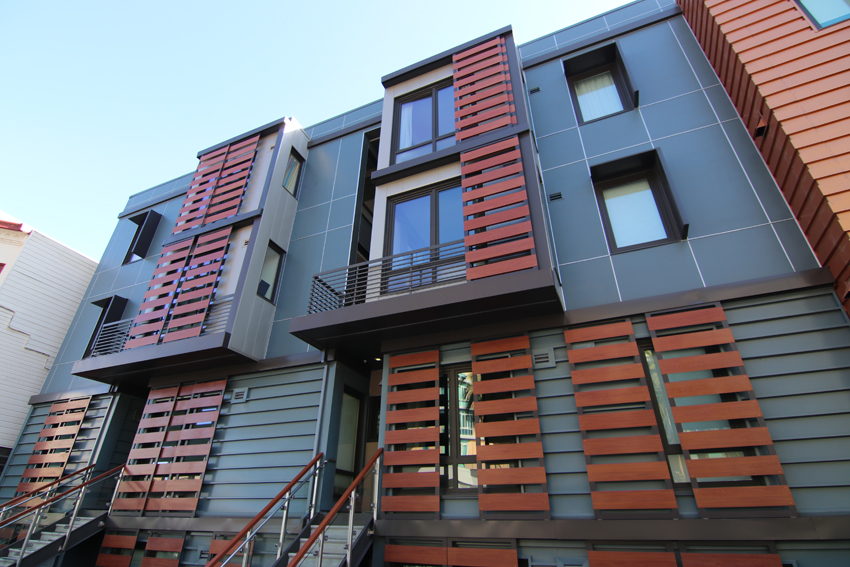
Aluminum lasts a long time before it needs to be replaced, and its light-weight quality and ability to be recycled make it an ideal green building material.
Conclusion
With the multifamily residential housing market booming to provide affordable, modern dwellings for both the Baby Boomer and Millennial generations, building professionals and interior designers have to think out of the box when it comes to materials. Extruded aluminum can be used to achieve modern design goals while protecting interior drywall surfaces from the wear and tear of rental and high-turnover properties, such as apartments and condominiums.
In addition, extruded aluminum has high potential for construction of healthy buildings, especially in a post-pandemic world where the best materials for counteracting pathogens may be desired or even required.
Finally, as extruded aluminum products for construction become more diverse, the aesthetic qualities of finishes will grow with demand. Along with aesthetics, the need to keep costs down will continue to balance out the sustainability and product quality of extruded aluminum.
Erika Fredrickson is an independent writer and editor focusing on technology, the environment, and history. She is a frequent contributor for continuing education courses and publications through Confluence Communications. www.confluencec.com









